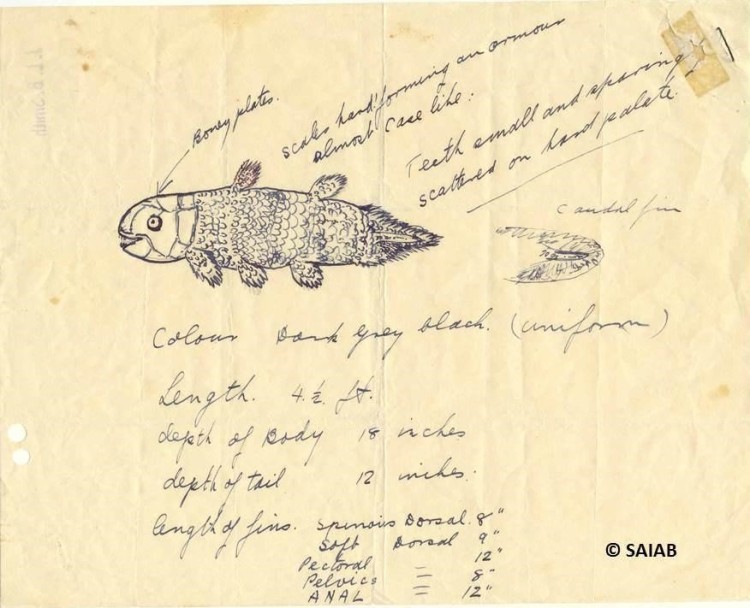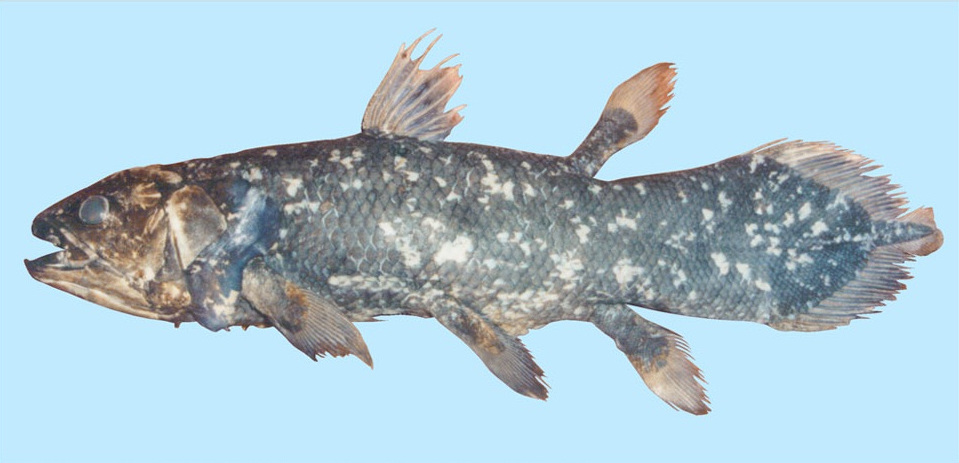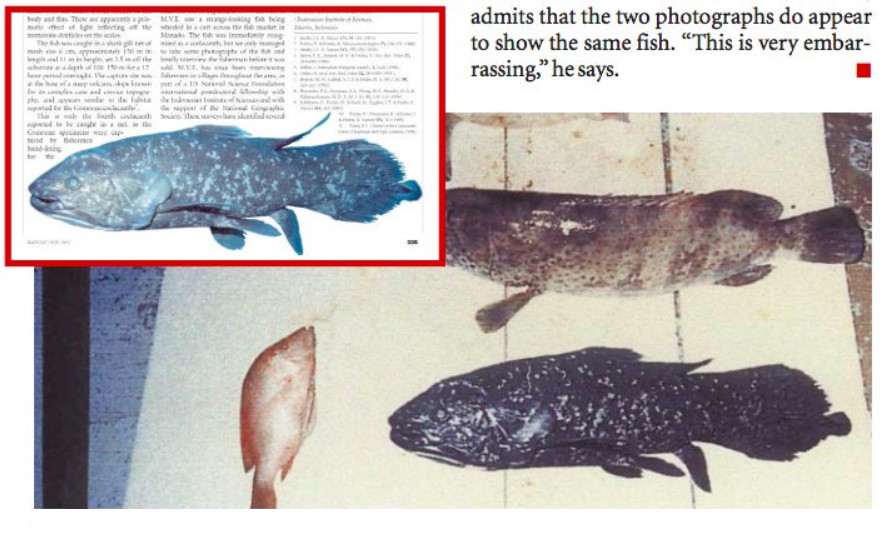Diduga ikan purba tertangkap pancing, @lpsplsorong lakukan sosialisasi perlindungan Coelacanth (Latimeria menadoensis) pada 2 orang pegiat mancing mania Sorong yang menemukan ikan tersebut di perairan Raja Ampat. #lindungitorang #gitalaut #OurOcean #DJPRLkeren @DitjenPRL @kkpgoid pic.twitter.com/BHwTfZy3Hv
— LPSPL Sorong (@lpsplsorong) July 2, 2018
In the two decades since its serendipitous discovery, the Indonesian Coelacanth (Latimeria menadoensis) has proven to be a remarkably elusive fish. Just a half-dozen or so specimens have ever been reported, typically as bycatch in gillnets set out overnight for sharks. The species has also been observed by ROVs at a couple localities in Indonesia, and now an exciting new specimen has just turned up at a third site, helping to expand our limited knowledge of this mysterious species.
The story of the coelacanth’s discovery is one of the most famous in the annals of zoology. The group to which it belongs, the sarcopterygian subclass Actinistia, was thought to have gone extinct along with the dinosaurs 65 million years ago… that is, until one was miraculously netted up by a South African fishing vessel in 1938. It’s discoverer, a young museum curator named Marjorie Courtenay-Latimer, initially had little idea what she had found, other than it was a fish unlike any known at the time. It was the esteemed ichthyologist J.L.B. Smith who eventually confirmed the identity of her specimen as a living coelacanth, belonging to a distinctive group of lobe-finned fishes closely related to the lungfishes and tetrapods (i.e. amphibians, reptiles, mammals). This remarkable find would be named Latimeria chalumnae, after its inquisitive discoverer and the Chalumna River from whence it had been collected.
And for many years, that was it for the coelacanth. The occasional specimen would turn up in the nearby Comoros Islands, where the healthiest population seems to exist, along with a few more from neighboring locales in the Indian Ocean, like Kenya, Mozambique, and the western coast of Madagascar. Coelacanths live in low abundance within caves and under ledges in the deep rariphotic reefs there, predating on other fishes with the help of a unique joint in their cranium that enables their face to hinge upwards, helpfully expanding the size of their gape. Imagine opening your mouth by tilting your face up independent of your skull; these are apparently the only vertebrates that can do this neat party trick.

The initial sketch of the first coelacanth. Credit: Courtenay-Latimer / SAIAB
The story of how the second coelacanth species came to be discovered is another tale worth telling, even though it is usually overshadowed by its more famous cousin’s origin story. In 1997, ichthyologist Dr. Mark Erdmann was on his honeymoon in the resort town of Manado in the northern tip of Sulawesi. His wife Arnaz—you might recognize her from the beautiful Chrysiptera arnazae, a species Mark helped describe—noticed a peculiar fish being wheeled about in a market. It was a rarely seen creature, collected just a few times a year, and known to the locals as the “oil grouper” or raja laut, the “King of the Sea”.
Mark immediately recognized it as a coelacanth, but, well, I’ll let Mark tell what happened next… “Although I was aware that as of my school days, the coelacanth had not been reported outside of the Western Indian Ocean, I had not followed the literature since that time and felt that our ‘discovery’ was a bit too fortuitous to be real. I simply couldn’t believe that we were viewing something which was unknown to science, having just stepped out of a taxi at a bustling market in a relatively large city.”
And, so, Erdmann neglected to secure one of the most important ichthyological finds of the century. Instead, this priceless specimen was reportedly sold at the market for just $12 and was no doubt turned into some tasty Indonesian cuisine. As it turned out, Erdmann was quite wrong about the Indonesian coelacanth, and he’d soon have to return to find a second specimen. Eventually, after offering a modest cash reward for the raja laut, another would be found in July of 1998 still alive in the net of Om Lameh Sonatham, who promptly brought it over for study. Mark and Arnaz had the unusual privilege of swimming alongside this remarkable beast as it swam its last fleshy strokes underwater, snapping the first ever photos of this species in life. Soon after, Erdmann published an initial account of the find, but this is where our piscine tale begins to fill with intrigue and controversy.
Coelacanths are quite large creatures and obviously not the easiest things to transport and store in a remote tropical country. When Courtenay-Latimer found hers in 1938, she had nowhere to put it and, in a last ditch effort, was turned away from the cold storage of the local morgue. With nowhere to turn to, she had to have her specimen taxidermied. In the meantime, the internal organs had putrefied and were thus lost to science, and they would remain unknown and unstudied until a second specimen was finally found in 1952. Mark Erdmann’s Indonesian specimen was an object of enormous scientific value—the sort of find which careers are built upon—and it would soon find its way to the Indonesian Institute of Sciences (LIPI), where it was to be genetically sequenced by a team of researchers at the University of Texas and eventually described.
But unbeknownst to Erdmann and his collaborators, researchers at LIPI went back on their word, deciding that they would rather not wait for the genetic data to come in and would instead name this species themselves, no doubt hoping to secure the accolades that were sure to follow. Enlisting the help of geneticist and ichthyologist Laurent Pouyaud of the French Institute for Development Research (IRD) in Jakarta, this second team rushed our their own manuscript by January of 1999. Befitting a discovery of this importance, they submitted their study to the journal Nature, which, as luck would have it, had only days before received a separate manuscript from Erdmann!
The editors at Nature, recognizing something was afoot here, rejected the submission from Pouyaud, but this would by no means dissuade these rogue researchers from scooping this story. Instead, under the proverbial cover of darkness, this immensely important taxonomic find soon found refuge in the April edition of a journal that few ichthyologists have ever heard of. Comptes Rendus publishes the proceedings of the French Academy of Science and has done so since 1666. In that 350+ year history, the journal has published precisely one species description for a fish, that of Latimeria menadoensis.
Now, this chicanery did not go entirely unnoticed. There was news coverage of this nerdy controversy in both Science and Nature. Erdmann disdainfully described the efforts of Pouyaud, stating, “All this guy did was stick some meat in a sequencer.” In retort, Pouyaud seemed to mock Erdmann’s frustration over the situation, likening himself to a “little David beat[ing] Goliath.” In the normally polite world of taxonomy, that is some ice cold shade.
Anyways, the point of this little foray wasn’t to reopen any old coelacanthic wounds, but, rather, to introduce a newly found population of the Indonesian Latimeria. As seen in the tweet at the top of this post, fishermen stumbled upon the first ever coelacanth at Raja Ampat, making it the 1,800th species of fish to be found in this biodiversity hotspot. Prior to this, L. menadoensis had been known solely from the type locality at Manado, Sulawesi (where all of the half-dozen or so specimens collected for science have come from) and from ROVs that observed them in situ further east at Biak, the island that partially closes off Cenderawasih Bay in West Papua.
Unchanged for 400 million years, even the 'living fossil' coelacanth isn't immune from our trash. Not the best advertising for @LAYS. #plasticpollution #plasticfree pic.twitter.com/AFpy8OdSkr
— Blue Planet Society (@Seasaver) August 8, 2018
These localities sit around 760 miles (1230 km) apart from one another, as the crow flies, and together they mark the rough edges of an ecoregion that has been observed in other groups of reef fishes. For instance, the undescribed Papuan Fairy Wrasse is endemic here, as are a number of the Hemiscyllium epaulette sharks, and some of the damselfishes in the Chrysiptera oxycephala complex, and perhaps Chaetodontoplus dimidiatus as well (assuming that one is truly a valid species, which seems reasonable enough). Point is, there’s something peculiar going on in this central portion of the Coral Triangle. Some combination of biogeography and oceanography has contributed to create an important reef refuge right in the middle of the West Pacific.
An open question among biologists has been whether the staggering biodiversity of the Coral Triangle (with well over 2,000 species of fish!) stems from some innate quality that happens to foster speciation there or if it’s simply a result of overlapping geographic provinces blending together a bunch of disparate faunas. There is certainly some truth in that second notion, but, when looking at an evolutionary relic like the Indonesian Coelacanth, the uniqueness of these reefs becomes readily apparent. For reasons unknown, in this Papuan ecoregion, life finds a way.
But despite the immense interest in this genus, there is still a surprising amount of basic information that we have yet to learn about the coelacanths. The description of L. menadoensis by Pouyaud et al. was riddled with errors and woefully inadequate for a find of this importance, as was pointed out by none other than Mark Erdmann in his eventual article in PNAS. A follow-up study by Wirjoatmodjo & Tjakrawidjaja 2002, collaborators of Pouyaud’s, gave a bit more detail into the morphology of the holotype specimen, but it still wasn’t clear how to tell the species apart from its Indian Ocean congener. In the years since, we’ve gotten quite a bit more genetic data for these two, but, without any close relatives to compare them against, our understanding of the timing of their speciation is more or less a guess, which has varied anywhere from 3-40 million years depending on the methodologies used.
https://youtu.be/ESXy27mcDDw?t=60
So, to summarize: for one of the most singularly fascinating fish groups on the planet, we don’t really understand when or why they split into the two known species, nor do we know how to tell them apart aside from looking at their DNA. We also don’t really know for sure that there aren’t more coelacanths out there waiting to be found. There’s been at least one unsubstantiated claim of a sighting from West Java, where the rariphotic reefs are minimally studied. It’s not hard to imagine these reclusive fishes hiding out elsewhere in the Indo-Pacific, though this may simply be wishful thinking, as surely they’d have been noticed in some remote fish market by now?
But I’ll end this meandering sarcopterygian tale with a final anecdote relating to our friend Latimeria menadoensis and the questionably competent individuals who named it. Shortly after Pouyaud published his description and Erdmann’s follow-up appeared in PNAS, the editors at Nature received a third account of this species’ discovery, which, it was alleged, predated all of this. As the story goes, a 10-kg specimen had been collected by fishermen in the Bay of Pangandaran, West Java in 1995 and was sent to the French Institute for Development Research to be examined. Recall that this was the same institution that employed Pouyaud, and, surprise surprise, he was listed as a coauthor on this astounding new claim, alongside Mssrs. Bernard Séret and Georges Serre.
Alas, this mysterious Javan specimen was somehow lost along the way, but not before Mssr. Serre was able to snap a photograph. But things are never quite so simple with Latimeria, and this photo was also somehow lost, only to be rediscovered—how appropriate for a coelacanth—in 2000. The only problem was that this photo was a painfully obvious fraud. It was Mark Erdmann’s published photo from his 1998 article… of the specimen described by Pouyaud in 1999… which had been poorly edited into another fish photo. The fins were positioned identically, and the patterning of light scales—a unique trait in every specimen—was an exact match. It was 100% undeniably the same damn fish. But, naturally, when confronted with this subterfuge, Serre stuck to his story, saying the photo was given to him by the widow of a dearly departed friend. The third author of this claim, Mssr. Séret, an ichthyologist at the prestigious Muséum National d’Histoire Naturelle de Paris, responding by saying, “This is very embarrassing.”.
Indeed.
- Abe, Y., 2007. Morphological Comparison of the Indonesian Coelacanth, Latimeria menadoensis and African Coelacanth, Latimeria chalumnae. In Proc. Int. Symp. The Coelacanth, Fathom the Mystery (pp. 19-24).
- Erdmann, M.V., Caldwell, R.L. and Moosa, M.K., 1998. Indonesian ‘king of the sea’ discovered. Nature, 395(6700), p.335.
- Erdmann, M.V., 1999. An account of the first living coelacanth known to scientists from Indonesian waters. Environmental Biology of Fishes, 54(4), pp.439-443.
- Fricke, H., Hissmann, K., Schauer, J., Erdmann, M., Moosa, M.K. and Plante, R., 2000. Conservation: Biogeography of the Indonesian coelacanths. Nature, 403(6765), p.38.
- Higasa, K., Nikaido, M., Saito, T.L., Yoshimura, J., Suzuki, Y., Suzuki, H., Nishihara, H., Aibara, M., Ngatunga, B.P., Kalombo, H.W. and Sugano, S., 2012. Extremely slow rate of evolution in the HOX cluster revealed by comparison between Tanzanian and Indonesian coelacanths. Gene, 505(2), pp.324-332.
- Holden, C., 1999. Dispute over a legendary fish. Science 284:22–23
- Holder, M.T., Erdmann, M.V., Wilcox, T.P., Caldwell, R.L. and Hillis, D.M., 1999. Two living species of coelacanths?. Proceedings of the National Academy of Sciences, 96(22), pp.12616-12620.
- Inoue, J.G., Miya, M., Venkatesh, B. and Nishida, M., 2005. The mitochondrial genome of Indonesian coelacanth Latimeria menadoensis (Sarcopterygii: Coelacanthiformes) and divergence time estimation between the two coelacanths. Gene, 349, pp.227-235.
- McCabe, H. and Wright, J., 2000. Tangled tale of a lost, stolen and disputed coelacanth. Nature volume 406: 114
- Nulens, R., Scott, L. and Herbin, M., 2011. An updated inventory of all known specimens of the coelacanth, Latimeria spp. South African Institute for Aquatic Biodiversity.
- Pouyaud, L., Wirjoatmodjo, S., Rachmatika, I., Tjakrawidjaja, A., Hadiaty, R. and Hadie, W., 1999. Une nouvelle espèce de coelacanthe. Preuves génétiques et morphologiques.
- Sudarto, Lalu, X.C., Kosen, J.D., Tjakrawidjaja, A.H., Kusumah, R.V., Sadhotomo, B., Pouyaud, L., Slembrouck, J. and Paradis, E., 2010. Mitochondrial genomic divergence in coelacanths (Latimeria): slow rate of evolution or recent speciation?. Marine biology, 157(10), pp.2253-2262.
- Wirjoatmodjo, S. and Tjakrawidjaja, A.H., 2002. ADDITIONAL DESCRIPTIVE DATA FOR THE NEW COELACANTH, Latimeria menadoensis Pouyaud et al. FROM SULAWESI, INDONESIA. TREUBIA, 32(1), pp.95-101.












0 Comments